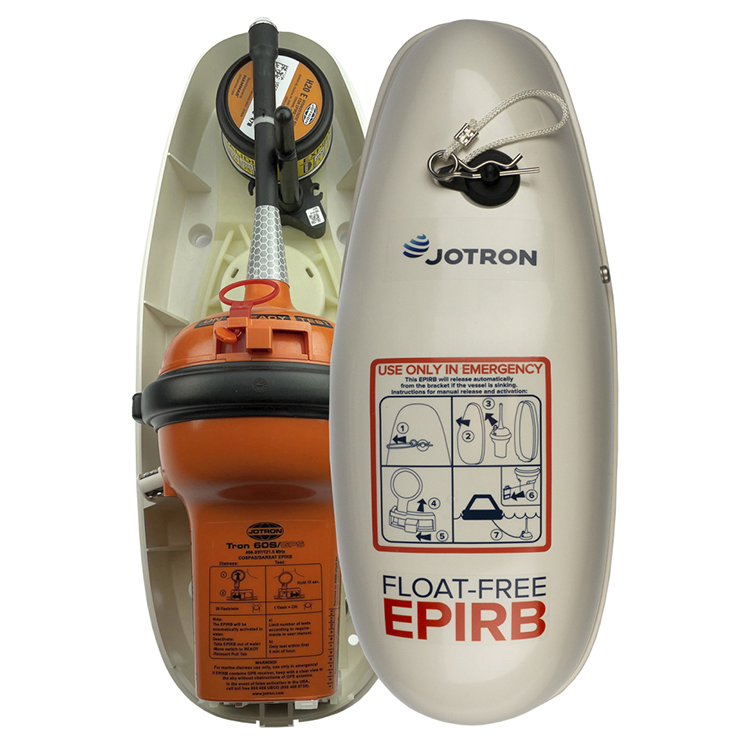What is An Emergency Position Indicating Radio Beacon (EPIRB)? 219
by Admin
Posted on 31-10-2023 11:59 AM

emergency
position indicating radio beacon (epirb) is a device to alert search and rescue services (sar) in case of an emergency out at sea. It is tracking equipment that transmits a signal on a specified band to locate a lifeboat, life raft, ship or people in distress. They are installed on ships and other vessels after being registered with the national search and rescue forces to that boat.
 The registration allows confirmation of false alerts faster and quick rescue operations in case of emergencies. An epirb is a secondary means of distress alerting, which is to say that it comes later in the hierarchy of alerting sar authorities in case of distress.
The registration allows confirmation of false alerts faster and quick rescue operations in case of emergencies. An epirb is a secondary means of distress alerting, which is to say that it comes later in the hierarchy of alerting sar authorities in case of distress.
In a world where technology has revolutionized the way we communicate and navigate, safety at sea or in remote wilderness areas remains a paramount concern. Whether you’re a seasoned mariner, an adventurer exploring remote regions, or simply someone who enjoys spending time outdoors, understanding the importance of an emergency position indicating radio beacon (epirb) can be a lifesaving endeavour. An epirb, short for emergency position indicating radio beacon, is a compact, self-contained device designed to transmit a distress signal to search and rescue authorities in the event of a life-threatening emergency. These emergencies can occur at sea, on land, or in remote areas where traditional forms of communication may be limited or unavailable.
In the vast and unforgiving expanse of the world ’s oceans, where human presence is but a speck in the grandeur of nature, safety at sea has always been a paramount concern. For centuries, mariners have navigated treacherous waters with a constant awareness of the perils that can strike at any moment. Among the many innovations aimed at ensuring their safety, the emergency position indicating radio beacon (epirb) stands as a beacon of hope, a lifesaver born from the union of technology and necessity.
Beginning january 1, 2007, both 121. 5 and 243 mhz emergency position indicating radio beacons (epirbs) are prohibited from use in both commercial and recreational watercraft. Boaters wishing to have an emergency rescue beacon aboard their vessel must have a digital 406 mhz model. The january 1, 2007, date to stop using 121. 5 mhz epirbs is in preparation for february 1, 2009, when satellite processing of distress signals from all 121. 5/243 mhz beacons will terminate. Following this termination date, only the 406 mhz beacons will be detected by the international cospas-sarsat satellite system which provides distress alert and location data for search and rescue operations around the world.
How Does An EPIRB Work?
An epirb is an emergency position indicating radio beacon, which is a device that is used at sea to alert search and rescue services (sar) in distress or an emergency.
 Working in a similar way to a plb, an epirb is installed on vessels and are registered to a specific boat, rather than a person, via the national search and rescue organisation. In most countries, it is mandatory for all commercial vessels to have an epirb registered.
Working in a similar way to a plb, an epirb is installed on vessels and are registered to a specific boat, rather than a person, via the national search and rescue organisation. In most countries, it is mandatory for all commercial vessels to have an epirb registered.
An epirb or eme rgency position indicating radio beacon is a distress beacon for boaters that when activated alerts a worldwide search and rescue (sar) network designed to send rescuers to your exact location quickly.
To test your epirb, hold the "test" button until the epirb starts flashing. If everything is working correctly it will flash 3 times, completing the test -- remember, it is recommended that you test your epirb once per month! all models are different and have different test buttons/processes, please follow instructions on the unit to verify the proper self-tested method. If your epirb does not show clear or favorable results, it could mean your battery is low or something else is wrong. If you have any questions feel free to call us at (206) 782-3302, one of our technicians can walk you through the process.